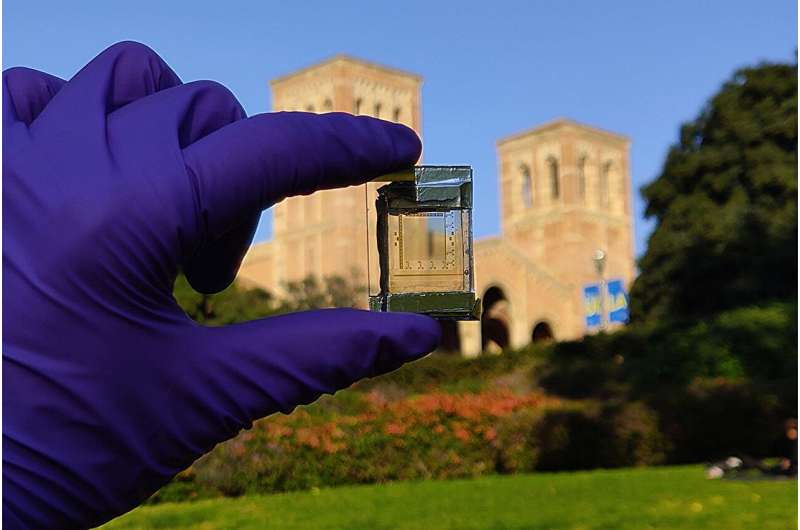The experimental setup uses two-dimensional semiconductor materials developed by Duan Xiangfeng, a professor of chemistry and biochemistry at UCLA.Image source: Zhang Dehui
Researchers developing next-generation computing technology aim to bring some light to the field. Optical computing relies on light particles called photons and is expected to become an alternative to traditional electronic methods. The light-based components of such systems or hybrid systems also retain electronic components, allowing for faster, less energy-consuming and more efficient computing of visual information through simultaneous parallel processing.
Until now, optical computing has faced limitations in achieving nonlinear responses, meaning the resulting signal is not proportional to the input. Nonlinearity enables general computing applications, including artificial intelligence.
The nonlinear materials and devices being developed require large amounts of light to operate. Previously, this required high-power lasers that only operate within a narrow band of the electromagnetic spectrum; absorb light over time, making processing slower; or use inefficient materials that absorb large amounts of light but hinder the required optical efficiency or Transparency application.
Now, a recent collaborative research effort by members of UCLA’s California Nanosystems Institute (CNSI) has unveiled a device that overcomes these obstacles.
Researchers at CNSI have shown that arrays of tiny transparent pixels can produce fast, broadband, nonlinear responses through low-power ambient light, an important step toward optical computing for processing visual information. The team also demonstrated an app that combines their device with a smartphone camera to reduce glare in images.The study was published in nature communications.
“Optical nonlinearity lags far behind the needs of our vision computing applications,” said co-corresponding author Aydogan Ozcan, professor of engineering innovation at the UCLA Samueli School of Engineering. “We need low-power, broadband, low-loss, and fast nonlinear optical systems to meet our visual computing needs. This work helps fill this gap.”
In addition to the glare reduction demonstrated in the study, potential applications for the technology include a variety of consumer and industrial uses: improved sensing in self-driving cars; cameras that could identify certain objects while hiding others; image encryption; and Efficiently and effectively detect defects in robotic assembly lines, etc.
This device can offer many advantages. For example, incoming images can be processed without being converted into digital signals, speeding up results and reducing the amount of data sent to the cloud for digital processing and storage. The researchers envision tying their technology to cheap cameras, compressing the data to produce images with much higher resolution than previously achieved, and more precisely capturing useful information about the arrangement of objects in space and the electromagnetic spectrum present in light.
“An inexpensive device a few centimeters in size could enable a low-power camera to work like a super-resolution camera,” said Ozcan, a professor of electrical and computer engineering and bioengineering at UCLA and associate director of CNSI. “This would enable high-resolution The democratization of imaging and sensing.”
The device under study is a 1 cm2 transparent surface. It uses a two-dimensional semiconductor material (presented as a thin film only a few atoms thick) developed by co-corresponding author Xiangfeng Duan, a professor of chemistry and biochemistry at UCLA.
The thickness of the material makes it transparent while retaining properties that enable incident photons to efficiently modulate conductivity. The research team combined a two-dimensional semiconductor with a layer of liquid crystal and made it work through an array of electrodes. The result is a smart filter composed of 10,000 pixels, each capable of selectively and rapidly darkening in a non-linear manner when exposed to broadband ambient light.
“Basically, we want to use a material that doesn’t absorb a lot of light, but still generates enough signal to process the light,” Duan said. “Each pixel can go from fully transparent to partially transparent to opaque. It only takes a small number of photons to significantly change transparency.”
“This unique opportunity led to a very, very exciting collaboration,” Duan said. “It’s exciting to think outside of our comfort zones. It showed me that as a materials developer I could benefit from exploring applications beyond basic research or proof-of-concept.
“We hope to continue down this path,” he added. “This is just the beginning. There’s certainly a lot more to do.”
Other co-authors, all affiliated with UCLA, include doctoral students Dong Xu, Yuhang Li, Jingxuan Zhou, Yu Cheng Zhang, Boxuan Zhou, Peiqi Wang, and Ao Zhang; postdoctoral researchers Luo Yi, Hu Jingtian, Li Xurong, and Ren Huaying; Bai Bijie , who will receive his PhD in 2023; Mona Jarrahi, professor of electrical engineering at Northrop Grumman; Huang Yu, professor and director of the Department of Materials Science and Engineering.
More information:
Dehui Zhang et al., Broadband nonlinear modulation of incoherent light using transparent optoelectronic neuron arrays, nature communications (2024). DOI: 10.1038/s41467-024-46387-5
Provided by UCLA
citation: Advances in light-based computing demonstrate capabilities of future smart cameras (2024, April 15), Retrieved April 19, 2024, from https://techxplore.com/news/2024-04-advance-based- capability-future-smart.html
This document is protected by copyright. No part may be reproduced without written permission except in the interests of fair dealing for private study or research purposes. Content is for reference only.
#Advances #lightbased #computing #demonstrate #capabilities #future #smart #cameras
Image Source : techxplore.com
